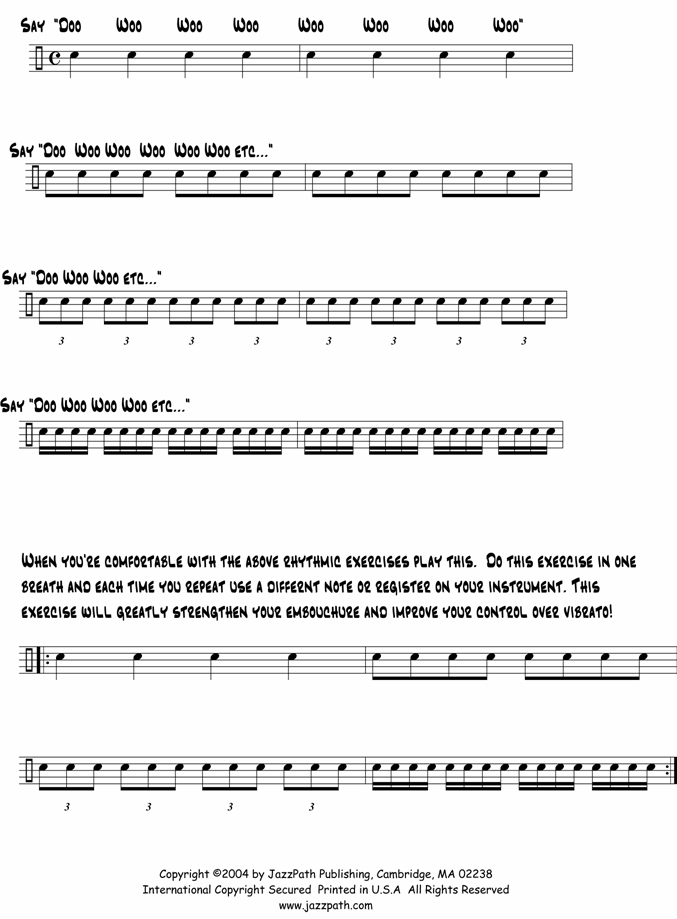Vibrato for Beginners
By Brian J Kane
Vibrato is the most common note inflection in music. Even though vibrato is extremely common, student musicians often find that generating a consistent and steady vibrato is quite challenging. The following exercises will help you generate and gain control over your vibrato. strive to make vibrato a habit. The use of consistent quality vibrato will make you sound more musical, emotional, and mature.
Step 1: What is Vibrato?
Vibrato is a rapid pulsation of pitch that is used as an inflection on a note. There are many ways to play vibrato.
- Diaphragm or Throat Vibrato occurs when a musician uses his or her air stream to produce controlled pitch pulsations.
- Slide Vibrato occurs on trombone when a musician uses small slide movements to produce controlled pitch pulsations.
- Finger Vibrato occurs on valve instruments when movement of the right hand above the valves creates actual movement of the instrument producing controlled pitch pulsations.
- Lip Vibrato occurs on many wind instruments when tiny embouchure movements create controlled pitch pulsations.
I teach, recommend, and use lip vibrato on saxophone. I recommend lip vibrato because over the years my students have found it easy to learn and control. Feel free to choice any type of vibrato that is suitable to your instrument.
Step 2: Generating a Lip Vibrato
On saxophone, generating a quality vibrato can be as easy as speaking. I prefer to teach students using word phrases to help them remember key concepts.
- Say "Doo-woo-woo-woo-woo" etc. The "Doo" sound is the legato articulation that begins the note. Many wind players prefer to use a "T" sound for articulations. If you prefer to use "T" sounds for articulations, say "Too-woo-woo-woo" etc. The "woo" sound represents the physical motion that your embouchure will make to generate vibrato. The motion is small but rhythmically consistent. When you attempt to play vibrato, do not actually say ANTHING! Your vocal chords are not used. Simply use your lips to imitate the sound of "Doo-woo-woo-woo-woo" etc. or "Too-woo-woo-woo" etc.
- Practice holding out long sustained notes and while pulsating the pitch. Don't worry about controlling the rhythmic pulsations yet, just get used to the feeling.
- Experiment with using vibrato in different registers of the instrument. It can feel quite different in the low register versus the high register
Step 3: Controlling Vibrato
It is essential to view vibrato in the context of rhythms. Play the following exercises on your instrument first using a legato articulation. Once you're comfortable with the rhythms remove the legato articulation and sustain a single long note while pulsating vibrato in the rhythms given.

Step 4: Which Rhythmic Feel Do I Use For Vibrato?
There are some general guidelines to choosing the type of vibrato used in compositions.
- Jazz and Swing- tend to use a triplet or eighth note vibrato. Vibrato tends to sound slightly "looser" with less even pitch pulsations.
- Classical- Tend to use an eighth note or a sixteenth note vibrato. In these styles the vibrato tends to be more regulated with more even pitch pulsations.
Using vibrato is one of the many ways that musicians express emotion through their playing. The most important guideline to follow when using vibrato is to make sure that it sounds good! Feel free to take liberties with rhythmic feel and the velocity of vibrato if it reflects how you feel and sounds good.
Step 5: When Do I Play Vibrato?
When you're first learning to use vibrato and make it habit, I suggest using it virtually all of the time. Here are the guidelines I give my students.
Use Vibrato when...
- The note is held 2 beats or longer
- The note occurs at the end of a phrase, is not short, and is followed by a rest.
- Any other place where you feel it might be appropriate
Step 6: How do I make Vibrato a Habit?
The greatest challenge that a student musicians faces when learning vibrato is remembering to use it. Often, student musicians are overwhelmingly focused on playing the correct notes and rhythms. The simple way to ensure that vibrato becomes a habit is to WRITE IT IN EVERYWHERE IT WILL BE PLAYED!
First, decide what type of vibrato you'll use. Will it be triplets, or eighth notes, or sixteenth notes, or a combination At the top of the composition that you're playing write the name of the type of vibrato that you're going to play. Then, write in where you're going to play the vibrato in the composition. You can write the word "Vibrato" over the appropriate notes or you can just draw a squiggly line to help you remember. When you're sight reading and learning new music you will not remember to play vibrato if you don't write it down! Writing down information is the best way to create a habit. Eventually, you will automatically play vibrato in the appropriate places without even thinking about it. But until that time, WRITE IT DOWN.
Good luck with this beginners guide to vibrato. Practice hard!
Brian J Kane is a jazz educator and saxophonist in the Boston area. He is
the author of the Jazz Style and Technique Workbook for Saxophone and the
Creative Jazz Sight Reading Workbook available for all instruments. He is
presently working on a series of workbooks for melodic improvisational
techniques. He can be reached at
Brianjkane@jazzpath.com